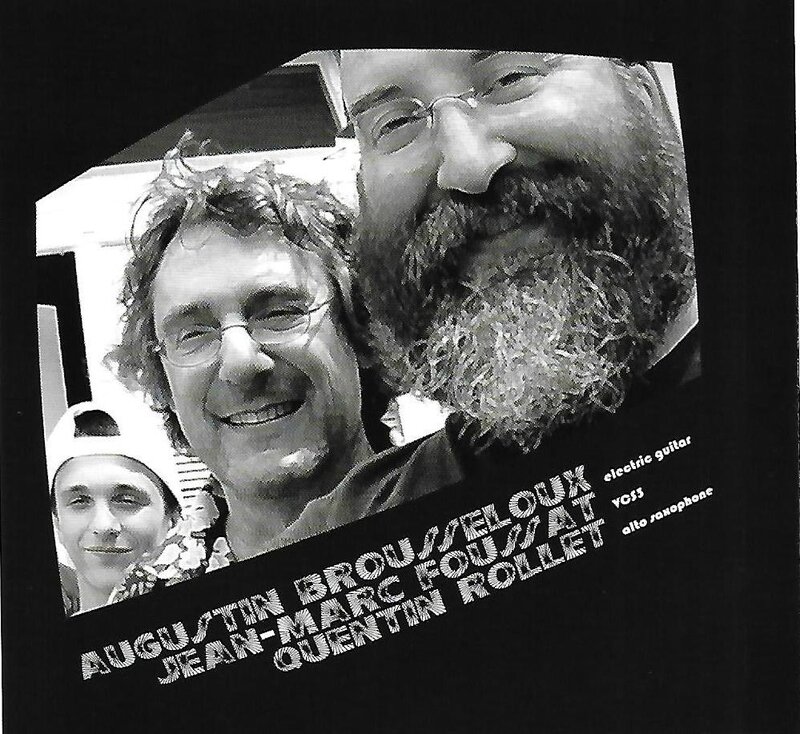1 : inversement chose
Des sons à peine audibles, puis progressivement émerge une pâte sonore, granuleuse, aux lacérations métalliques, comme une masse magmatique qui avance, inexorable et sombre, entraînant de gros débris industriels, puis une forme de chant indistinct.
Le saxophone enfin, avec d'étranges sons comme une machine qui lâcherait brutalement sa vapeur, par à coups. Un souffle des profondeurs qui laisse échapper quelques scories. La fascination est installée, prégnante. Des éclats aux sax, des roulements, des plaintes, un discours tourmenté enserré dans cette masse sonore sombre qui avance, inéluctablement, et des sons graves, une guitare, industrielle et poétique, à la puissance onirique peu commune.
Puis cette masse se fait plus légère, des lignes de guitares répétitives, vaguement espagnoles ou presque bluesy, nostalgiques. Rien n'est installé, tout se transforme. Une voix déformée tient un discours inaudible. Des paysages émergent, se fondent, complexes et séducteurs, captivant les oreilles, propulsant l'imaginaire, pinçant le bout du cœur .
Vers la fin de la pièce, un solo étourdissant d'Augustin Brousseloux, entrelacé de nappes au synthétiseur, de chants étranglés au sax ... les espaces industriels se déploient puis tout se tait, sur une note de guitare, seule.
2 : fugitif irrationnel
Cela débute comme un chant au sax sur des notes répétitives à la guitare. Ce chant s'exaspère, s'éraille, se brouille, s'égosille, perd toute raison, plonge dans les profondeurs du souffle pour tournoyer ensuite dans les aigus, des nappes aux pulsations répétitives formant écrin. Un Quentin Rollet superlatif, impressionnant de maîtrise, d'imagination. Et toujours ces magmas sonores complexes, instables, à la respiration régulière, terreau de nouvelles efflorescences à la guitare, de nouvelles virevoltes au sax. Une sombre beauté élaborée dans les secrets alambics de Jean-Marc Foussat.
Cet assemblage de talents produit des univers sonores insoupçonnables, d'une puissance onirique assez rare. Un album remarquable !
Prendre son temps et finir bluffé chez Improvising Beings
- Joëlle Léandre & Théo Ceccaldi - Elastic (Cipsela)
This was the year of Léandre: our weeklong celebration seems hardly enough. There are a number of albums that could have gone here: the tentet on Ayler, the 8CD set on Not Two, the historic performance on Fou, and on and on. Her turn here with Ceccaldi is simply gorgeous music.
- Augustin Brousseloux, Jean-Marc Foussat, Quentin Rollet - Qui A Vu Ce Mystère… (Improvising Beings)
There were also a number of notable Foussat releases this year, but this one with the (extremely!) young Brousseloux is a knock-out.
- Judson Trio (Joëlle Léandre, Mat Maneri, Gerald Cleaver) - An Air of Unreality (RogueArt)
Two Léandre albums in the top three may seem excessive, but that's the kind of year she had. Maneri and Cleaver are also at the height of their powers.
- Rodrigo Amado Motion Trio - Desire and Freedom (NotTwo)
Three long, glorious, lyrical cuts from Amado and his superb trio with Miguel Mira and Gabriel Ferrandini.
- Battle Trance - Blade of Love (NNA Tapes)
Even more intense, intimate, spirited, melodic, ambitious, and virtuosic than Palace of Wind. If you can believe it.
- Lotto - Elite Feline (Instant Classic)
The trio of ?ukasz Rychlicki, Mike Majkowski, and Pawe? Szpura conjure stunning, trace-inducing atmospheres out of bare-bones material.
- Eve Risser White Desert Orchestra - Les Deux Versants Se Regardent (Clean Feed)
A hugely ambitious offering from Risser that showcases the many talents in her orchestra. A late year release that might have climbed even higher had there been more time to absorb it.
- Julien Desprez, Benjamin Duboc, Julien Loutelier - Tournesol (Dark Tree)
Duboc has long been a favorite, and the two Juliens were new to me. This short album doesn't give up its secrets easily--every time I listen, it seems to be completely different from the times before.
- Aly Keïta, Jan Galega Brönnimann, Lucas Niggli - Kalo - Yele (Intakt)
Infectious music. An ode to rhythm.
- Bushman's Revenge - Jazz, Fritt Etter Hukommelsen (Rune Grammofon)
Admittedly, I've never been a big Bushman's Revenge fan, but this album is superlative. Some of the best "jazz" guitar I've heard in years.



